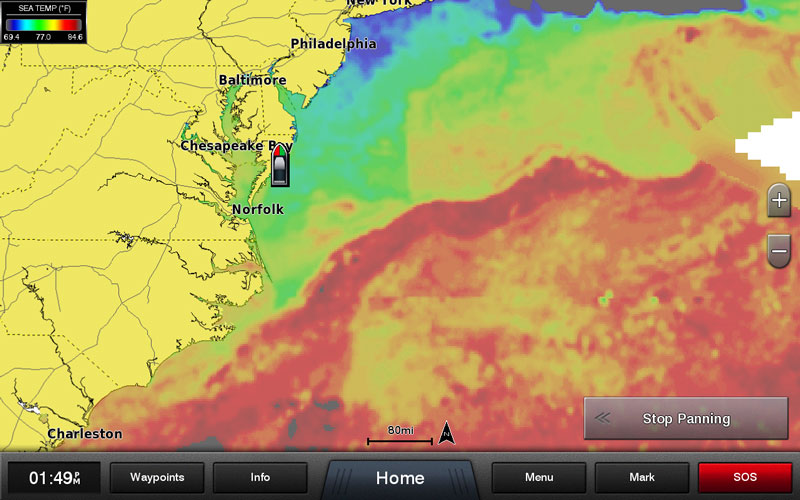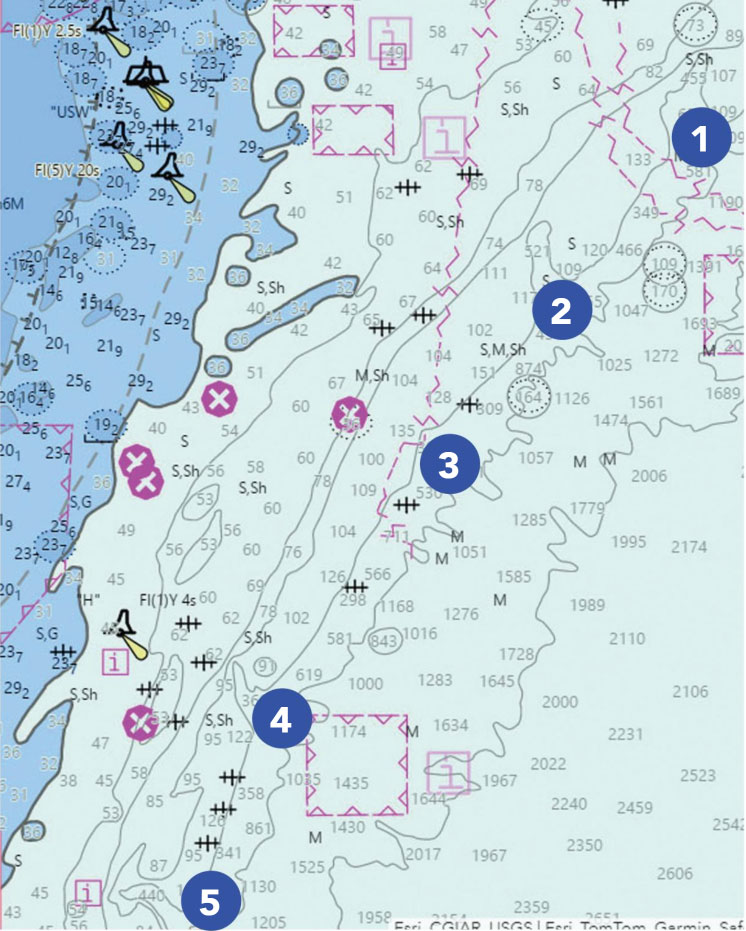Presented by Sirius XM Marine
As early season yellowfin tuna cruise up the coast the next month is likely to be a good one. Or, maybe a great one. Of course, there’s no telling just how hot the bite will be months, weeks, or even days in advance. Will we get a swirl of warm water breaking off the Gulf Stream, heading inshore, and bringing the fish with it? Will big schools of sand eels tempt those tunas into staying for a while? Will storms and wind make it tough to get off the dock even as the fish are chewing? All we can do is hope for the best, but when you cast off the lines and point the bow eastward you’ll certainly want to have every advantage in your favor.
Finding the Yellowfin Tuna
You probably know this already, but we’ll say it yet again: finding oceanic breaks and barriers is key. And, as we’ve also pointed out before, this means staying up on eddies and currents with sea surface temperature (SST) charts, finding plankton fronts, and ideally locating areas where the two coincide. SiriusXM Fish Mapping is a top pick in this regard, not only because they’re FishTalk supporters (yay!) but also because having it aboard lets you look at the positions and movements of those temp breaks and plankton fronts when you’re actually out there on the water — right on your chartplotter — as opposed to predicting where they’ll be after looking at days-old data the night before.

Another factor we’ve delved into before is intel gathering, which we examined in detail last month in “Offshore Fishing Intel.” If you missed it, be sure to check the article out. One item we have yet to explore, however, is also one of the most obvious ways to find fish: head for the canyons. Wilmington, Baltimore, Poormans, Washington, and Norfolk Canyons are all within reach of most of the fishing boats (more or less) running out of Mid-Atlantic ports like Indian River, Ocean City, and Virginia Beach. These jagged rips in the Continental Shelf catch the ocean currents and create upwellings, swirls, and eddies that regularly hold fish. They also have contours and structure that attract crustaceans and ground fish, which both helps bring in larger predators and also provides a backup plan in case the pelagic species don’t cooperate. But. There’s always a but, and we’ll get to that later. First, let’s take a quick look at each in turn.

Wilmington Canyon
The Wilmington is the farthest north and is also one of the largest canyons off our shores, cutting west and then towards the north into the sea floor. The tip can be phenomenal but the pair of bowls eaten into the west side also produce spectacular catches at times, as can the northern bight. Expect its western edges to out-produce other portions more often than one might guess.
Baltimore Canyon
The next canyon moving south is the Baltimore, which also juts in and to the north but is slightly smaller and has less abrupt drop-offs in the tip. As a result the bights and especially the northern bight are often a good bet here.
Poormans
Poorman’s isn’t as much a true canyon as it is a pair of crescent cuts into the edge of the shelf. Still, the change in geography is enough to cause current changes and distortions and at times it can be incredibly productive. Poormans also has bottom conducive to golden tilefish, always a good plan B.
Washington
Thanks to the “bigeye hole” (the northern notch in the east wall), the Washington is one of the most popular destinations around. And yes, a lot of bigeye are caught here — as are yellowfin, billfish, and more. The northern bight is also a reliable producer, and both bights hold golden tilefish in the 650’ to 850’ depth range.
Norfolk
The Norfolk is a bit different than canyons to the north as it takes a westward turn and the tip doesn’t shift towards the north like the others. Both bights can be hot and since there’s rockier bottom in the tip, catches like wreckfish become more likely when baits are dropped to the bottom.
Now, for the but: the canyons counter-intuitively create a trap of sorts for many anglers. We always hear about this canyon or that one, and it’s a big ocean out there so making a canyon your destination just about always seems like a good idea. And it’s true that being at one of these cuts in the shelf means you can try different options like deep-dropping or bailing lobster floats for mahi. However, the presence of fish like tunas will be dictated by the water currently in them and the presence (or lack thereof) of bait.
Offshore sharpies won’t simply pick a canyon and head for it. Instead, they’ll study the SST, or if they’re armed with SiriusXM they’ll look at the most current satellite shots available both before leaving the dock and when arriving on the scene. And they’ll recognize that a temperature break swirling across an open edge of the shelf is a better bet than the canyons themselves if the water in them is blasé. They may also stay inshore of the shelf if there’s an eddy of water swirling inside. They’ll remember that when it comes to pelagics, physical structure is only one part of the equation and temperature-based structure is every bit as important.

Tempting the Tuna
When it comes to tuna, finding the fish is generally the toughest part of the battle and stock-and-trade tactics usually get them to bite. We’ve covered basic tuna trolling tactics plenty of times in FishTalk so we’re going to skip it here; if you need a refresher go to the website, look for the search box in the upper right corner of this webpage and type in “tuna trolling.” Sometimes, however, you’ll find yourself around tuna that are playing hard to get. In recent years during the midsummer months this has included encountering breaking fish which were 100-percent unwilling to attack trolled baits and lures, which is why we have a feature on how to get them snapping by casting topwater lures in next month’s edition (stay tuned!).
Along with topwater there are a number of tactics you can try to get unwilling fish biting. Sometimes one or another will work but there’s just no way to predict which will do the trick, so when you’re sure there are tunas around but your baits go unmolested be sure to try:
- Set a string of small (four- to five-inch) cedar plugs behind the boat, keep the rod in hand, and jig it erratically as you troll.
- Rig a “dangler” by putting a plastic squid on a two-foot dropper line, 20’ in front of a large plug or chugger. Run it back from a long rigger position and set it so the squid dips into the water intermittently.
- Fly a kite and skip a plastic squid or flying fish along the surface.
- Rig a small squid and pull it on a light leader (see “Rigged Squid Saves the Tuna Fishing Day” at FishTalkMag.com).
- Get a bait down deep via a planer or “poor man’s downrigger” line.
Safety for Offshore Anglers
Running to the edge of the Continental shelf in your own boat is a big endeavor, one which will push the safety margins for just about any recreational angler. If you missed last month’s article on small boat safety offshore be sure to check it out at the website. And remember:
- Carry an EPIRB, PLB, or satellite messenger so you have some form of panic button aboard.
- If you don’t already have SiriusXM consider adding it to your system so you get near-real-time weather displayed right on your MFD screen, including storm tracking and wind forecasts.
- Make sure your VHF radio has functional DSC, meaning it has GPS data and has been registered with an MMSI number. Then if you call the Coast Guard, they’ll automatically have your exact position.
So, how will June of 2024 play out on the offshore grounds? We’re not about to try and make any predictions. But one thing is for sure: if those tuna come cruising up the coast you’ll have to find ‘em and tempt ‘em, and having every advantage in your favor is a good way to help make that happen.
